
BY Jotham Chiketa THE term real estate refers to land and buildings attached to it.
I would like to start by examining land tenure in Zimbabwe. In the colonial era, land was divided into tribal trust lands for the majority of black people and land for white settlers was differently set aside.
The land for the white people was large in extent and fertile whilst the land for the black people was small and not very rich and fertile.
There was also land for wildlife conservation, safaris as well as historical monuments such as the Matopo Hills where the late Cecil John Rhodes was buried.
At Independence in 1980, there was a land reorganisation which culminated in the repealing of the tribal trust lands and the coming into existence of the Command Land Act.
There was farming at subsistence land where households could only produce for their own consumption with surplus for sale.
The activities here were on a very small piece of land because of the set-up and nature of the community.
There was no expertise on communal farming as well as funding.
- Chamisa under fire over US$120K donation
- Mavhunga puts DeMbare into Chibuku quarterfinals
- Pension funds bet on Cabora Bassa oilfields
- Councils defy govt fire tender directive
Keep Reading
The communal land had no value in it according to Section 4 of the Command Land Act.
It was under the jurisdiction of chiefs and headmen who could only allocate people traditionally although some people have acquired rights to stay and use the land through prescriptive title.
The communal land is vested with the President of the Republic of Zimbabwe and he or she administers it through an Act of Parliament.
Therefore, the communal land may not be sold since it cannot be exposed to open market dynamics.
Whereas commercial farms may be sold because they have title deeds and can be exposed to open market dynamics hence, they have a significant value on them.
There was also the small-scale commercial farming and the large-scale commercial farming.
On small-scale commercial farming, there were activities at a scale above subsistence farming because of availability of funds from financial institutions and expertise through extension services as envisaged by the government. The produce is entirely for sale.
The large-sale commercial farming had more sophisticated equipment and modern techniques of farming which produced for sale and to feed the nation.
Large-scale commercial farming was heavily funded by the banks and had expertise of the extension services, training and management of farms.
Small-scale and large-scale commercial farmers had title deeds which came into effect through the issuance of the deed of grant or the deed of transfer whichever way it came.
The wildlife, parks and fauna remained unchanged but laws governing them have always been enacted and statutory instrument put in place for amendments here and there.
In all of the above, at times there was a haphazard settlement and hence, there was disorder, wrong use of land, overcrowding which posed a health hazard. This culminated in the birth of Regional, Town and Country Planning Act.
Furthermore, land in towns was organised in the following manner by the white settlers; the eastern side was set aside for the white people and the western side for the black people.
Today, the settlement of the land is done according to densities such as high, medium and low-density which is determined by one’s own purse.
To this end, cities such as Harare, Bulawayo, Mutare etc have their developments put into densities as well as zones. The land has been zoned into industrial and residential.
In industries, for example in Harare, there are heavy industries and light industries which are Workington and Graniteside, respectively. In residential areas, there are high, medium and low-densities with the advent of upper lower density which comes with gated communities such as in the Borrowdale Brook where land is beyond the reach of many people.
Residential and industrial properties as well as farms and plots have individual ownership through the issuance of a deed of grant or deed of transfer, once one has purchased a property on cession, which is acquired through the local authority or local government awaiting to be issued with title deeds after the development to which they belong has attained the certificate of compliance.
- Jotham Chiketa is a member of the Real Estate Institute of Zimbabwe and writes here in his personal capacity. He may be contacted through email on [email protected].











